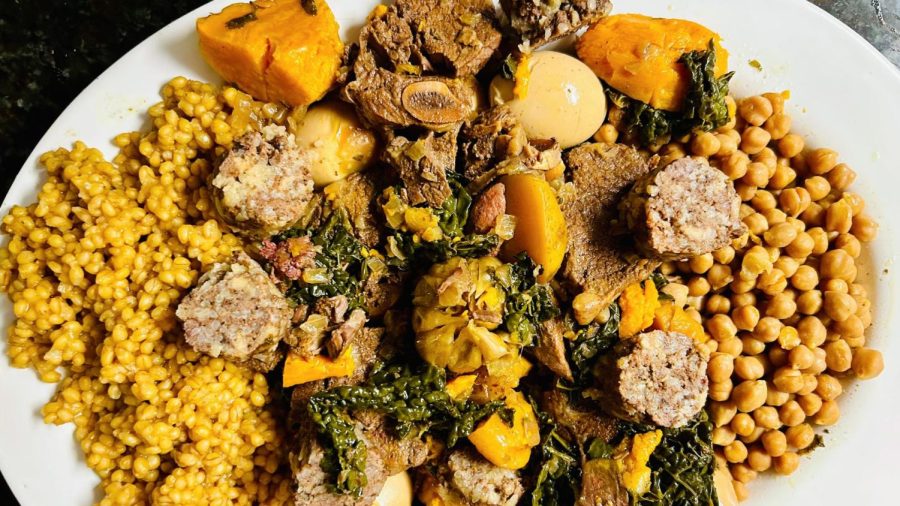Understanding Adafina, the Shabbat stew of Spains Conversos
Published March 27, 2023
“Food is who we are in the deepest sense, and not because it is transformed into blood and bone. Our personal gastronomic traditions—what we eat, the food and foodways we associate with the rituals of childhood, marriage, and parenthood, moments around the table, celebrations—are critical components of our identities. To recall them in desperate circumstances is to reinforce a sense of self and to assist us in our struggle to preserve it.”
— Cara DeSilva, “In Memory’s Kitchen: A Legacy from the Women of Terezin”
So much of our Jewish culinary heritage has been determined by where our people have lived in the world, and in many cases where they suffered through pogroms or expulsions—England in the 1200s, France in the 1300s, Spain in 613 and again in 1391 and again in 1492, and Portugal in 1497. Through each of these tragedies, our ancestors struggled to preserve their culinary traditions and, when their lives were at risk, adapt those traditions in ways that turned their food into virtual lifeboats.
While there are many examples of how Jewish culinary ingenuity was valuable in helping to preserve Jewish tradition, there are two examples that stand out for me. I covered the first one back in March of 2019, in a column about the Portuguese “Jewish Sausage” known for centuries as Alheira. This clever (and delicious) sausage masqueraded as a typical pork sausage, which, when hung outside the home in backyard smokehouses, signaled to their neighbors and the Portuguese government officials that these Jews had fully converted to Catholicism by abandoning the laws of kashrut.
A second example was in Spain during the pogroms of 1391, when many thousands of Jews were murdered, and tens of thousands of others chose to convert to Catholicism as a way to save themselves and their families. But many of these Conversos, known as Crypto-Jews, remained Jews at heart and still observed the precepts of Judaism, including holidays, Shabbat, and of course, the laws of kashrut. A fine example of their resolve is evident in their Shabbat stew.
The traditional stew of Spain is called Olla Podrida. It is made with pork, ham, pork sausages, and lard (rendered pork fat) along with chickpeas, vegetables such as cabbage and carrots, garlic, and bay leaves. The Spanish Catholics typically served this stew as a family meal on Sunday after Church services. But the Crypto-Jews would substitute olive oil for lard, and beef or chicken along with whole eggs in their shells (known as huevos haminados) in place of the various pork products. Chickpeas, vegetables (whatever greens were available), a grain, garlic and cinnamon. To suspicious neighbors and the authorities, this Converso stew—which came to be known as Adafina—could pass for the Olla Podrida eaten by their Catholic neighbors.
Another difference between the two stews is the cooking method. Olla Padrida could be prepared in a few hours, while Adafina required 12 hours. That’s because our Converso ancestors needed to assemble their stews prior to sundown on Friday and cook them on a very low temperature thus not requiring them to be reheated. This allowed Conversos to maintain the laws of the Sabbath. However, these families, unlike their Catholic neighbors, enjoyed their stew on Saturday, and thus caution was of the utmost importance.
Adafina, just as its Ashkenazi relative cholent, is still made by Jews around the world, perhaps with adjustments depending on the availability of ingredients. New world vegetables such as potatoes and tomatoes, a variety of beans, and spices such as ginger, allspice and turmeric, have become more common ingredients. For example, Sephardic Jews make their Dafina (as it is called by Moroccan Jews) with potatoes, chickpeas, and wheat berries, and others with sweet potatoes and dried fruits such as dates, raisins, and dried apricots. The Moroccan version of the stew is served over rice, while the Algerian and Tunisian versions, called Tafina, are served over couscous. All of this convinced me that so much can be learned about a cuisine simply by looking into a potful of stew and inhaling the aromas!
One quick aside: while you can still make Adafina in an oven at a low temperature, you can also make it in a Crock Pot, thanks to the Jewish inventor Irving Naxon, (originally Nachumsohn, the surname of his Russian immigrant parents). Inspired by the Ashkenazi Sabbath stew cholent, he created the Naxon Beanery. And while the Naxon Beanery never gained popularity, Rival Manufacturing acquired it in 1970 and trademarked it as the Rival Crock-Pot.
While I have prepared cholent before, I had never made Adafina. I found different recipes and ended up putting together my own, borrowing what seemed like the best ideas from the many I had read. If there are ingredient in my recipe that don’t speak to you, leave them out or substitute something you prefer.
After making my Adafina (and serving it to six friends), we found that the sweet potatoes disintegrated after the long slow cooking process. I would not include them again. In my adjusted recipe below, I substituted carrots cut into big chunks for the sweet potatoes. We did like the apricots, though raisins would have been a better choice than dates, which also also disintegrated. Because the stew needed a kick, I included an additional 1/4 tsp. of cayenne pepper along with freshly ground black pepper at the end of my recipe. Feel free to increase the amounts or omit them altogether. Everyone enjoyed the condiments, which allowed each person to add the flavors they most enjoyed.
Please do not be put off by the long list of ingredients. This recipe comes together quickly with little effort. Furthermore, the thrill of creating a meal of such provenance is uplifting and enjoyable! Disfrute de su comida! (Ladino for “enjoy your meal.”)
Recipe: Adafina (also known as Daphnia, Skhina)
Click here for a printable version of this recipe
Ingredients
3/4 c. dried chickpeas, soaked overnight, rinsed and drained
1 1/4 c. wheatberries, soaked overnight, rinsed and drained
For the sausage:
½ lb. lean ground beef
1 slice bread, crusts removed, soaked in warm water and squeezed dry
1/2 tsp. salt
1/8 tsp. freshly ground black pepper
1/2 tsp. ground ginger
1/4 tsp. ground allspice
1/8 tsp. ground nutmeg
1/8 tsp. ground cloves
2 tbsp. uncooked white rice
To assemble the adafina:
1/3 c. olive oil
2 medium onions, peeled and coarsely chopped
2 tsp. coarse kosher salt, divided, plus more to taste
½ tsp. ground turmeric
½ tsp. sweet paprika
½ tsp. cayenne pepper
1/4 tsp. crushed red pepper flakes
2 lbs. flanken, brisket, or beef stew meat
6 Yukon gold or red new potatoes, halved
1 bunch lacinato kale, rinsed, ribs removed and greens torn into 3- to 4-inch pieces
1 lb. carrots, cleaned and cut into 3-inch chunks
½ tsp. ground cinnamon
1/4 tsp. ground allspice
½ tsp. ground cumin
1/4 tsp. cayenne pepper
1/4 tsp. freshly ground black pepper
6 saffron threads
½ c. chopped fresh flat leaf parsley
1 whole head (bulb) of garlic, loose papery covering removed, head kept whole
½ c. raisins
6 dried apricots, halved
6 large eggs in their shells
Water (or water and half beef or vegetable broth) to cover
1/3 c. honey
Optional condiments:
• Fresh mint leaves
• Pickled red onions
• Muhamarra sauce (a middle-eastern condiment made with roasted red peppers)
• Harissa (North African pepper paste)
Note: You will need both cheesecloth and kitchen twine to prepare this recipe, along with a large pot that has a lid and is oven safe.
Directions
1. Cut two 12-inch pieces of cheesecloth and set each one in a small bowl. Pour the soaked chickpeas into one bowl, pull the edges of the cheesecloth to the center and tie tightly, making sure to leave lots of space for the beans to expand as they cook. Set aside.
2. To the second cheesecloth lined bowl, add the wheatberries, again bringing the edges of the cheesecloth to the center and tie tightly, making sure to leave space for the wheatberries to expand. Set aside.
3. To make the sausage, mix all the ingredients together in a medium bowl. Cut a double layer of aluminum foil paper, 10×16-inches. Place the sausage mixture on the center of the foil paper, forming it into a sausage shape. Roll the foil paper tightly around it to look like a sausage. Set aside.
4. Heat the olive oil in a large oven-proof pot over medium heat. Add onions and 1/4 tsp. salt and sauté until translucent, but not browned, about 5 minutes. Spread onions out to evenly cover the base of the pot. Set aside.
5. Combine 1/2 tsp. salt, the turmeric, sweet paprika, cayenne pepper and red pepper flakes in a small bowl. Rub the mixture onto the meat and evenly layer it over the onions. Top with both the bean and wheatberry packets, on different sides of the pot.
6. Top with kale, followed by the new potatoes and carrots. Sprinkle evenly with 3/4 tsp. salt, cinnamon, allspice, cumin, cayenne pepper, black pepper, saffron threads and parsley. Set the whole head of garlic in the center of the pot, pushing it down enough into the layers so that it is secure. Place the sausage in the center of the pot, pushing down on it lightly.
7. Scatter the dates and apricots evenly as the next layer and, using a tablespoon, push down through the stew to make 6 spaces for each of the eggs. Very gently tuck in each of the eggs into the six spaces. Add enough water (or half water and half beef or vegetable broth) to cover and drizzle honey and 1/2 tsp. salt over the top. Bring mixture to a light boil on the stovetop, cover with a lid, and reduce to a simmer. Simmer for 1 hour.
8. Preheat oven to 225 degrees.
9. Transfer lidded pot to oven and bake for 5-6 hours. (Check after 4 hours to make sure there is still liquid in the pot. If there isn’t, add another cup of water. If there is too much liquid, remove the lid and continue cooking for the additional hour.) Alternatively, oven can be set to 200 degrees and the Adafina can cook overnight for 12 hours.
10. To serve, unwrap the beans and wheatberries and place at either side of a large platter. Unwrap the sausage and cut into 6-8 pieces. Arrange the beef (slice brisket, if using) next to the beans and grains and place the remaining portions of the stew in the center, topped by the sausage. Arrange the eggs evenly around the platter.
11. Pass small dishes of the condiments, if using, around the table.
Makes 6-8 servings.
















